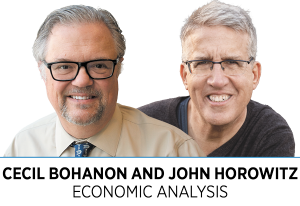Subscriber Benefit
As a subscriber you can listen to articles at work, in the car, or while you work out. Subscribe Now Robert Merton and Harriet Zuckerman discussed how eminent scientists receive more credit for the same work than less well-known scientists. They called this the Matthew Effect, referring to Matt. 25:29 in the Bible: “For whoever has will be given more, and they will have an abundance. Whoever does not have, even what they have will be taken from them.”
Robert Merton and Harriet Zuckerman discussed how eminent scientists receive more credit for the same work than less well-known scientists. They called this the Matthew Effect, referring to Matt. 25:29 in the Bible: “For whoever has will be given more, and they will have an abundance. Whoever does not have, even what they have will be taken from them.”
For income, the Matthew Effect is the rich getting richer and the poor getting poorer. One way to look at the rich and the poor is to look at quintiles. Quintiles are calculated by ranking households from the richest to the poorest and then dividing households into five equal groups, or quintiles. The richest 20% are in the top quintile, and the poorest 20% are in the bottom quintile.
Since 1967, real average household income has increased for all quintiles. Annual growth rates were 0.4% for the bottom quintile, 0.6% for the second quintile, 0.7% for the third quintile, 0.9% for the fourth quintile, and 1.5% for the richest quintile.
Rising inequality was primarily because the richest quintile’s incomes increased faster than households in other quintiles.
The poor’s incomes increased. Using 2019 numbers to adjust for inflation, average income in the bottom 20% increased from $10,738 in 1967 to $15,286 in 2019.
A household’s current position in the income distribution is affected by where that household was previously. For example, from 2009 to 2012, about 69% of those in the lowest income quintile remained in the lowest income quintile, and about 71% of households in the top quintile remained in the top quintile. For the other quintiles, about half remained in the same quintile. However, mobility increases over longer time periods.
Whatare the primary predictors of upward mobility? In a 2015 article, Raj Chetty and his co-authors found households in cities like San Jose, California, and Salt Lake City are more mobile than households in cities like Indianapolis and Charlotte, North Carolina. They found that family structure was the largest determinant, and children with married parents are more upwardly mobile. Likewise, the quality of the K-12 school system and having good social networks and community involvement increase mobility upward. More recently, Chetty and his colleagues found that social connections between people of different economic backgrounds are important for upward mobility.
Both the rich and the poor are getting richer, though the rich are getting richer faster. We will leave it to the reader to decide what that implies.•
__________
Bohanon and Horowitz are professors of economics at Ball State University. Send comments to [email protected].
Please enable JavaScript to view this content.
